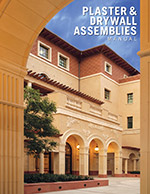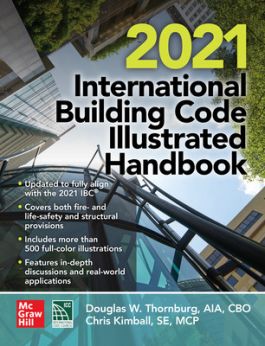Fire protection engineers and other fire-testing experts understand that fire resistance ratings are derived from tests run in a laboratory setting. However, based on the number of inquiries we receive at the association and what we have come to understand to be the perception of the public in general, we believe that a large segment of the population does not understand that fire ratings are actually based on tests conducted under highly controlled laboratory conditions; nor is it generally understood what “hourly” fire resistance ratings mean. The purpose of this article is to explain the meaning of the ratings for fire resistive systems, such as one, two, three, and four hours, that are usually incorporated into model and jurisdictional building codes where appropriate.
Most of the fire resistance rated walls or partitions constructed with gypsum board systems in the U.S. and Canada contain “type X” gypsum wallboard (or perhaps an improved variation with a proprietary trade name). Type X gypsum wallboard is manufactured in accordance with ASTM Standard C 36. ASTM C 36 is being phased out and will be replaced shortly by another standard, ASTM C 1396. ASTM C 36/1396 contains a provision that type X gypsum wallboard must meet specific criteria in order to “pass” a test defined in another ASTM Standard, E 119, “Standard Test Method for Fire Tests of Building Construction and Materials.” It is this widely accepted test method that is used to determine the hourly fire resistance ratings for systems constructed of gypsum board (as well as other materials).
The evolution of fire resistance methods
ASTM E 119 was initially published in 1918 (as ASTM C 19) and has been used continuously since then as the principal method to test the fire resistance of a variety of building materials that are used to construct fire resistance rated systems. (Similar protocols were developed later by other standards groups and laboratories, and are used and accepted in some cases.) A variety of refinements have been made to the E 119 standard since 1918; however, several of the test criteria, including the conditions required to “pass” an individual fire test, have remained essentially unchanged.By the standard’s own definition, ASTM E 119 does not assess individual materials or products for their fire-resistive characteristics. The test method described in the ASTM E 119 standard evaluates “the ability of an assembly (system) to contain a fire or to retain its structural integrity, or both, during the test conditions imposed by the standard,” the endurance time achieved as a result of the performance of the system being tested is converted to an hourly rating. ASTM E 119 only produces laboratory test results to be used to evaluate the general fire resistance of systems such as walls, columns, slabs, and floor- and roof-ceiling systems that contain diverse components.
Results from an E 119 test are not precise predictors of future performance of the system or of the individual products that make up the system. For example, the ASTM E 119 standard does not contain specific details for construction of the test furnace; because test furnaces are subject to variations due to individual characteristics of construction and design, including ventilation, atmospheric conditions, and general thermal tendencies, test results are typically not necessarily repeatable or reproducible from one laboratory to another. Additionally, differences in system components and construction methods, the design and control features of individual furnaces, and other variables regarding the testing regimen, can cause wide fluctuations in ASTM E 119 test results.
It is widely accepted by fire testing experts that a fire test may be properly viewed as a snapshot of a single system at a given time that includes the measurement of the performance of a specific system, composed of specific materials, constructed in a specific test furnace, on a specific day. This simply means that for a gypsum board system to receive a “one-hour fire resistance rating,” all requirements of an ASTM E 119 test were successfully met in a testing laboratory furnace for at least 59 minutes and 30 seconds (test results are rounded off to the nearest minute) for that specific system and with those specific components of the system.
What means an “hour”?
The hourly fire resistance ratings found in commercial and residential building codes that refer to an ASTM E 119 test are not meant to imply that a specific system will remain intact for the prescribed time of the hourly rating in an actual fire situation. Even if type X wallboard is referred to as one-hour board or has a one-hour fire rating, this does not mean that either a particular system incorporating type X wallboard or any given piece of type X wallboard will necessarily last for an hour in a different laboratory’s fire test or provide one hour fire protection in an actual fire.Referencing of the same test method(s) by the building codes facilitates the descriptions and comparisons of fire resistance ratings of systems that have been objectively evaluated by a neutral party. Numerical fire resistance ratings created by ASTM E 119 tests may be considered as points of reference for comparison purposes; the higher the numerical rating (i.e., one, two, three, or four hour(s)), the greater is the system’s comparative endurance.
By meeting requirements of independent third-party organizations, such as Underwriters Laboratories Inc., gypsum board manufacturers may label their type X wallboard as being acceptable for use in fire-rated systems based on criteria established by the third-party organizations. The third-party organizations may approve changes to gypsum board formulations using criteria, standards and engineering principles they judge appropriate, such as full-scale ASTM fire tests, small-scale fire tests, or engineering studies and evaluations. This means that in the judgment of third-party certification and labeling organizations, a full-scale ASTM fire test may not be required if other technical and engineering mechanisms are available to verify maintenance of quality.
Because of the technical and engineering experience and expertise of the labeling and certification organizations, the fact that a particular type X wallboard product has been deemed acceptable for use in one-hour fire resistance rated systems by one of the third-party organizations does not necessarily mean that the wallboard made according to that specific formulation has been subjected to a full-scale ASTM one-hour fire test.
Once a type X wallboard formula has been certified by a third party organization, the company using that formula to manufacture type X wallboard does not have to conduct periodic fire tests on that wallboard as long as the company follows the procedures established by that third party organization to ensure that the wallboard is manufactured in compliance with the certified formula.
In further efforts to maintain industry-wide quality assurance standards for type X gypsum wallboard, the Gypsum Association requires that all member companies listed in the generic systems contained in the Gypsum Association’s Fire Resistance Design Manual subscribe to an on-going, third-party, in-plant product inspection and labeling service. This objective certification and labeling process ensures that manufacturers continue to manufacture the same quality of product as that originally tested. (More information on Underwriters Laboratories testing, certification, follow-up, and labeling procedures is available at http://www.ul.com.)
In summary, it is widely recognized and accepted that the ASTM E 119 test method does not incorporate all dynamics essential for fire hazard analysis or fire risk assessment of the systems under conditions in an actual fire situation. The results of an ASTM E 119 test, therefore, should be regarded as one component among a variety of factors used to assess the potential of a system to perform as part of a structure.
For example, a rated wall separating a garage from the living space of a residence may have a door inserted that has a fire rating considerably less than the wall. Fire resistance classifications correlated with hourly benchmarks are based on results of tests conducted on systems created with specific materials and built in a specified manner; therefore, variations from the test conditions or the construction specifications (including, but not limited to, the type and size of materials and the method of construction) may affect the results of fire tests. Because fire exposure conditions vary with changes in a wide variety of factors, including the amount, nature, and distribution of available fuel; ventilation; and the size, configuration, and other characteristics of the compartment, the test method contained in the ASTM E 119 standard cannot be considered to be representative of all “real world” fire conditions.
Fire resistance ratings created through use of the ASTM E 119 test method reflect a relative measure of comparative system’s performance under specific fire test conditions in a laboratory. ASTM E 119 test results should not be construed as having determined performance of a system under different conditions.




